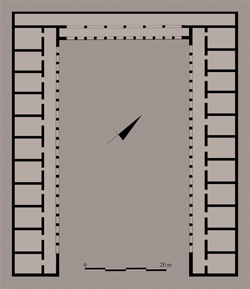download article as pdf: Il pasto collettivo nei santuari dell’Egeo meridionale: struttura e forme di partecipazione
.
This paper was presented at the International Conference Cibo per gli uomini, cibo per gli dei. Archeologia del pasto rituale, Piazza Armerina, 5-8 of May, 2005. This is now an updated version.
The stoà of Camirus, on the Acropolis sanctuary dedicated to Athana and Zeus Polieus, is one of the most important urban monuments in the southern Aegean sea. Several epigraphic texts speak about his function and use inside the sanctuary and mention the organization of meetings and banquets inside the rooms of the building. The rooms behind the portico, in fact, are organized in tree-rooms complexes that could be interpreted as hestiatoria or banquet houses, very similar at Macedonian or Egyptian prototypes. The archaeological and textual evidence prove that the stoà is a multifunctional structure that serves to religious and political necessity of the polis. Perhaps, it is also possible to locate in the structure the hierothyteion, testified by epigraphic fonts, in which public meals were offered by the polis itself.


